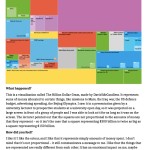How to keep a diary
About the diaries
In the week before the focus group we would like focus group participants to record all of their encounters with data visualisations. We’d like to know where and when they saw them, what their initial impressions were, and what they thought about the visualisations after looking for longer. To do this we would like focus group participants to keep a diary and to make diary entries every time they see a visualisation for one week prior to the focus group meeting (if they see a visualisation more than once there is no need to record it a second time).The video above and the text below explain how to keep diaries. The diary should describe all encounters with data visualisations during the week.
We ask participants to keep a diary for two reasons:
- to help immerse them in the world of visualisations so that they can come to the focus group meeting feeling confident that they know what visualisations are and when they are likely to see them in their own lives;
- to help us to understand when and where participants encounter visualisations and what impressions they make upon people in everyday settings.
Because we are interested in ordinary experiences of visualisations, so we ask participants to carry on as normal – there is no need to go out of your way to find visualisations to comment on.
Where you might see visualisations
You might see the visualisations in the newspaper (for example, the free commuter paper the Metro regularly has visualisations). You might see them on the television in news programmes (the weather maps count!) or documentaries, on sports programmes, or even in reality tv: Channel 4’s Secret Eaters uses them to discuss the nation’s eating habits, for example. You are very likely to see them online, too: we frequently see them in our social media feeds and on newsy websites. This is where you are much more likely to encounter interactive visualisations that you can play with and find out more information. You might see visualisations through the course of your work (data visualisations can be a frequently used part of business planning)- but you don’t have to include those.
How to keep your diary
You can keep your diary in a way that works best for you. This may be:
- Pen and paper/notebook
- Word processed (e.g. Microsoft Word, Open Office or Google Docs)
- Social media (e.g. Facebook, Pinterest, Tumblr)
- Smartphone/tablet apps (e.g. OnePAD, DayOne, Momento, Everyday Timeline)
Examples of diary entries:
Ideally participants would include a photograph, link to or copy of the visualisations in the diary, although there might be times when they are unable to do this – that’s fine. We ask participants to make their diary entries as soon as they can after seeing the visualisation and to write as clearly as possible. We ask participants to be honest – if a visualisation didn’t make sense or if you think it is ‘bad’, this is important information, so do record these kinds of feelings and impressions. If participants don’t see any visualisations on one of the days, it’s important to record this too.



